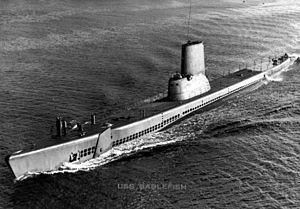Laid down 5 June 1943 Decommissioned 1 November 1969 Construction started 5 June 1943 Length 95 m | Commissioned 18 December 1945 Struck 1 November 1969 Launched 4 June 1944 Builder William Cramp & Sons | |
 | ||
Fate Sold for scrap, 29 July 1971 Class and type Balao class diesel-electric submarine | ||
USS Sablefish (SS/AGSS-303), a Balao-class submarine, was a ship of the United States Navy named for the sablefish, a large, dark fish found along North America's Pacific coast from California to Alaska.
Sablefish (SS-303) was laid down on 5 June 1943 by Cramp Shipbuilding Company, Philadelphia; launched on 4 June 1944; sponsored by Mrs. Carol S. Burrough, wife of Captain Edmund W. Burrough (former Captain, USS Cleveland); and commissioned at the Philadelphia Navy Yard on 18 December 1945, Comdr. Richard Henry Crane in command.
Following a shakedown cruise from New London, Conn., to Balboa, Canal Zone, the new submarine conducted type training in the Panama area until mid-May 1946. She then returned to her home port, New London, and spent the remainder of the year supporting ASW exercises off the east coast, participating in fleet exercises off Bermuda, and making a three-week cruise off Greenland.
Her duty in 1946 established a pattern for her operations during much of her subsequent career. Highlights of her service for the next few years were: testing a new type of submarine escape buoy in January 1948, and again in September of that year; participating in ceremonies at Havana, Cuba, on 14 February 1948, the 50th anniversary of the sinking of the battleship Maine; conversion to a Fleet Snorkel submarine during the first half of 1951; and a starring role in one of Edward R. Murrow's “See It Now” television shows.
On 15 July 1952, the submarine broadened her experience by departing New London and sailing to the Mediterranean Sea for her first deployment with the 6th Fleet. After exercises with other United States warships and vessels of the navies of NATO allies during the rest of the summer, Sablefish returned to New London in October. Thereafter, she made six more deployments to the Mediterranean.
When back on her home side of the Atlantic, the submarine was busy with exercises which took her as far north as Nova Scotia and south to the Caribbean.
In June 1959, she was one of the Navy's representatives at the opening of the St. Lawrence Seaway; and she operated in the Great Lakes until mid-August. A second cruise up the St. Lawrence returned her to the Great Lakes in 1961.
In May 1967, Sablefish again headed east across the Atlantic; but this time, instead of transiting the Straits of Gibraltar for service in the 6th Fleet, she visited ports in the British Isles and along the Atlantic coast in France, Germany, Denmark, and Sweden. On her homeward voyage, she also touched at Iceland.
The ship began her last Mediterranean deployment in the fall of 1968 and returned to her home port on 1 February 1969. On 30 June 1969, while operating out of New London, she was reclassified as an auxiliary submarine and redesignated AGSS-303. She was decommissioned there on 1 November 1969 and struck from the Navy list the same day. She was subsequently stripped and sold for scrap on 29 July 1971.
